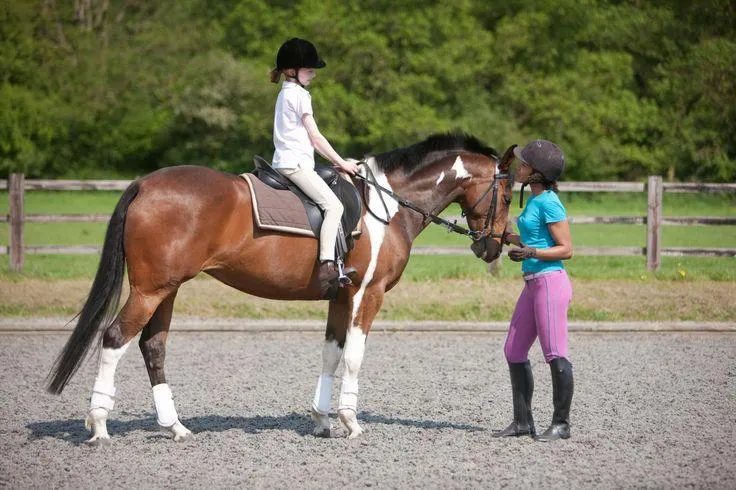
Make sure you keep up with our blog to see what we've been up to, learn training & riding tips & much more!

A Beginner's Guide to Riding
What to Expect as a New Horseback Rider: A Beginner’s Guide
Starting horseback riding is an exciting adventure! Whether you're interested in riding for fun, fitness, or competition, it’s essential to understand what to expect when you first step into the world of horses. Here’s a beginner’s guide to help you prepare for your first lessons and make your experience as enjoyable and safe as possible.
1. Getting Comfortable with the Horse
When you first start riding, you’ll spend time getting comfortable around the horse. It’s not just about hopping into the saddle—you need to learn how to interact with the horse, groom them, and build a bond. Before your first lesson, you might be introduced to the horse you'll be riding. Your instructor will guide you on how to approach, groom, and tack the horse properly. This helps you build trust and confidence, and it’s also an essential part of horsemanship.
2. The First Lesson: Starting Slow
On your first ride, don’t expect to jump into advanced maneuvers right away. Your instructor will start with the basics—teaching you how to properly mount, sit correctly in the saddle, and control the horse at a walk. This part of the lesson will focus on helping you feel comfortable and balanced.
At this stage, your instructor will likely spend time teaching you the basics of steering (how to guide the horse with reins), stopping (using reins and body cues), and starting (how to ask the horse to move forward). Don’t worry if it feels overwhelming at first. Riding is a skill that takes time to develop.
3. Focus on Your Position and Balance
One of the first things you’ll learn as a new rider is how to maintain proper posture and balance. It may feel a bit awkward at first, but don’t get discouraged! Your instructor will help you find a comfortable seat in the saddle, focusing on your heels down, shoulders back, and relaxed grip on the reins. This position allows you to communicate effectively with the horse and stay balanced throughout the ride.
You’ll also practice keeping your core engaged—a crucial part of riding that will help you maintain control and stay centered on the horse as they move.
4. Learning the Basics of Gait Transitions
After you get comfortable walking, your instructor will introduce you to trotting. Trotting is the next step up from walking and involves a bit of a bouncing motion, which can feel strange at first. But don’t worry, with practice, you’ll develop a rhythm and learn how to post (rise out of the saddle slightly) to make trotting more comfortable.
Your instructor will guide you through transitioning between gaits—going from a walk to a trot and back, as well as eventually learning to canter. Don’t expect to master this right away, but with time and repetition, you’ll get the hang of it!
5. Understanding Horse Communication
One of the most important things to understand as a new rider is how to communicate with the horse. Horses are sensitive creatures and respond to your body language and voice cues. During your lessons, you’ll learn how to use subtle movements, like squeezing your legs or shifting your weight, to guide the horse.
Your instructor will help you understand the horse’s signals and body language as well. Horses will often communicate through their ears, eyes, and body posture. Learning to read these signals will help you build a stronger connection with your horse and make your riding experience more enjoyable.
6. Safety is Key
Safety is a top priority, especially when you’re starting out. A good riding instructor will emphasize proper safety gear (like a well-fitting helmet and appropriate footwear), how to handle the horse correctly, and basic emergency procedures in case something goes wrong. Your instructor will always keep a close eye on you to ensure that you’re comfortable and safe throughout your lesson.
Many riding schools also have safe, well-trained horses specifically for beginners. These horses are gentle, patient, and familiar with the lesson process, which helps you feel more at ease.
7. Don’t Expect Perfection—Progress Takes Time
As a new rider, it’s important to be patient with yourself. Learning to ride takes time, and you may not get everything perfect in your first few lessons (and that’s okay!). You’ll have some days where everything feels right and others where it feels challenging. The key is to stay consistent and trust the process.
Your instructor will guide you step by step, celebrating each small victory along the way, whether that’s mastering balance, learning to steer, or building a connection with your horse.
8. Enjoy the Ride
Most importantly, remember that horseback riding is meant to be fun and fulfilling. Embrace the journey, no matter where you are on your learning curve. Enjoy the unique bond between you and the horse, the fresh air, and the joy of movement. As you continue with your lessons, you’ll notice improvements, gain confidence, and build a lasting love for riding.
Conclusion
Starting horseback riding lessons is an exciting and rewarding experience that’s full of new discoveries. From getting comfortable with your horse to mastering basic skills and learning how to communicate effectively, every step will build your confidence and connection with the horse. Don’t rush—take your time, enjoy the process, and before you know it, you’ll be riding with confidence and skill.
Are you ready to start your riding journey? Book a lesson today at STARS Sporthorses and take the first step toward becoming a confident rider!
